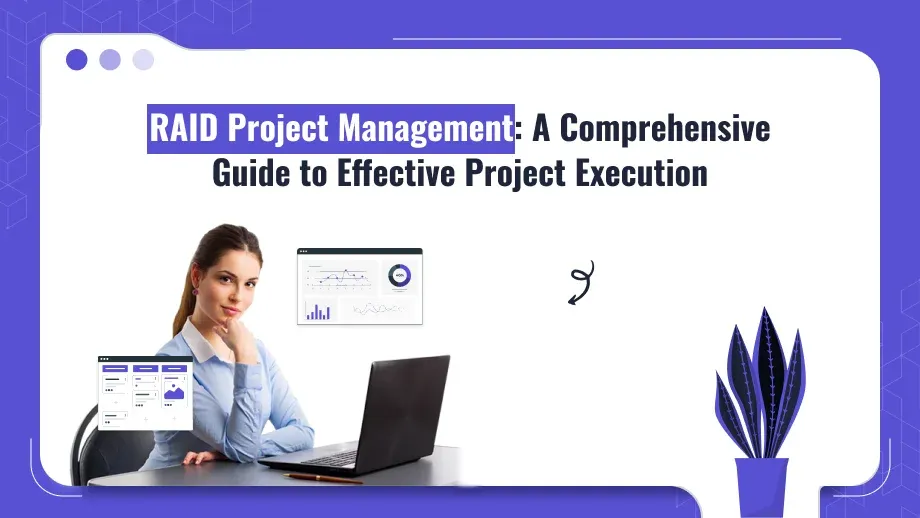
Effective project management and performance management documentation are critical for organizations to stay competitive and accomplish their goals in the fast-paced commercial world of today. The RAID log project management system is one useful tool that project managers can use. Teams may successfully negotiate complexities and achieve project success with this strategy, which focuses on Risks, Assumptions, Issues, and Dependencies. The RAID project management framework, its importance, essential elements, and implementation best practices will all be covered in this blog.
What is RAID in Project Management?
RAID stands for Dependencies, Assumptions, Risks, and Issues. This methodical technique aids project managers in recognizing, evaluating, and controlling critical components that may affect project results. Throughout the project lifecycle, teams may establish alignment and preserve clarity by concentrating on these four elements. Using a project charter template in this proactive framework improves overall project performance and facilitates improved decision-making.
Key Components of RAID Project Management
- Risks: Risks refer to feasible activities or situations that might also adversely have an effect on the desires of a project. By recognizing these dangers at an early stage, challenge groups can formulate mitigation strategies, thereby lowering the probabilities of detrimental results.
- Assumptions: In the context of planning, assumptions refer to beliefs or statements that are regarded to be accurate. Documenting assumptions is critical, as they can impact project execution if proven incorrect.
- Issues: Issues are current problems requiring resolution. Risks refer to conceivable problems, whereas problems are contemporary challenges that ought to be resolved rapidly to make sure the project’s advancement.
- Dependencies: Dependencies refer to the relationships between duties or initiatives that affect the distribution of assets and the timing of schedules. Understanding interdependence is necessary for efficient planning and delay prevention.
Project managers may increase visibility, encourage accountability, and guarantee projects are completed on schedule and under budget by controlling these four elements using a RAID log.
The Importance of RAID Project Management
Implementing the RAID framework in project management offers several benefits:
- Improved Visibility: Stakeholders can rapidly be aware of risks, assumptions, problems, and dependencies thanks to the RAID log’s clear viewpoint of challenge status.
- Proactive Management: By encouraging venture groups to apprehend and unravel viable troubles earlier than they end up greater serious, the RAID framework promotes extra environment friendly danger management.
- Improving Decision-Making: By planning and assessing project components, decision-makers can make better decisions that advance the project’s objectives.
- Enhanced Communication: The RAID organization encourages collaboration and transparency by facilitating open dialogue among team members and stakeholders.
- Better Accountability: By assigning accountability for risks, problems, and actions, the RAID framework makes sure that team members are held accountable for their contributions to the project’s success.
The Four Steps of RAID Project Management
The four primary steps of the RAID project management process are identification, documentation, monitoring, and review. Just like having a strong Project Charter establishes the framework for the entire project, comprehending these phases is essential to putting an efficient RAID framework into practice. The project’s goals, scope, and stakeholders are described in the project charter, which provide crucial background information for identifying and successfully managing the RAID project management components.
1. Identification
Finding the essential components of the RAID framework is the first step. This includes:
- Enhanced Accountability: The RAID framework encourages accountability by assigning blame for risks, problems, and actions. This makes team members accountable for their contributions to the project’s success.
- Recording Assumptions: Enumerate every assumption that was made when designing the project. This includes assumptions about resources, timelines, stakeholder engagement, and technology.
- Recognizing Issues: Encourage team members to report any current issues that arise during project execution. Prompt reporting allows for timely resolution and minimizes disruption.
- Mapping Dependencies: Identify dependencies between tasks and projects. Understanding these relationships is essential for effective scheduling and resource allocation.
2. Documentation
Once the RAID elements have been identified, the next step is to document them systematically. This includes:
- Creating a RAID Log: Establish a central RAID log in project management that serves as a repository for all identified risks, assumptions, issues, and dependencies. Every team member should have access to this document, which is updated frequently.
- Risk Detailing: List the possible consequences, likelihood of occurrence, and mitigation techniques for each risk that has been identified. Assign ownership for managing each risk.
- Recording Assumptions: Clearly outline each assumption, including its relevance to the project and potential consequences if it proves false.
- Tracking Issues: Document current issues, assigning ownership and priority levels to ensure accountability and effective resolution.
- Mapping Dependencies: Create a visual representation of task dependencies to clarify relationships and ensure proper scheduling.
3. Monitoring
Monitoring is an ongoing process that involves tracking project progress and addressing RAID project management elements as needed. Key activities during this phase include:
- Frequent Check-ins: Arrange for the project team to meet on a regular basis to go over the RAID project management log, talk about progress, and find any new risks, presumptions, or problems.
- Performance Metrics: To monitor project success objectively, use key performance indicators (KPIs). Align these metrics with the goals set during project planning to provide clear benchmarks.
- Adjusting Strategies: Be flexible and willing to modify plans based on emerging risks, changing circumstances, or team feedback. Adjusting goals and strategies ensures that the project remains on track.
4. Review
The final step in the RAID project management process involves reviewing overall project performance and assessing areas for improvement. This phase includes:
- Performing Evaluations: Organize formal project assessments to analyze the efficiency of the RAID process. Examine the successes and challenges encountered, and explore ways to enhance future projects.
- Data Analysis: Identify trends, patterns, and aspects that need enhancement within performance data. Make use of this data to guide choices about team building, resource allocation, and upcoming initiatives.
- Getting Input: Ask stakeholders and team members for their opinions on the RAID project management procedure. The framework can be improved and general project management techniques can be improved with the help of this input.
Challenges in Implementing RAID Project Management
While the RAID project management framework offers numerous benefits, organizations may encounter challenges during implementation. Some common obstacles include:
- Insufficient Risk Identification: During the identification stage, teams could fail to notice possible hazards. Later on in the project, this may provide unanticipated difficulties. Uncovered hazards might be found by involving a variety of viewpoints and encouraging candid conversations.
- Validation of Assumptions: Throughout the course of a project, assumptions may evolve. Failing to validate assumptions regularly can result in incorrect planning and execution. Set up frequent check-ins to examine and revise assumptions as necessary.
- Delays in Issue settlement: There may be problems that need the opinions of several parties, which causes delays in the settlement process. Create a transparent escalation procedure to guarantee accountability and handle problems quickly.
- Dependency Mismanagement: It can be difficult to monitor and efficiently handle the many dependencies that complex projects frequently have. Utilize project management tools that provide visibility into dependencies and allow for real-time updates.
Best Practices for Effective RAID Project Management
Take into account the following best practices to optimize the RAID framework’s advantages:
- Involve Stakeholders: Include stakeholders in the RAID Project Management process at all stages. Their knowledge can aid in risk identification, assumption validation, and more efficient problem solving.
- Update the RAID Log Frequently: Update the RAID log frequently to keep it up to date. This guarantees that everyone in the team is informed about the project’s progress and any modifications that could affect their job.
- Create a Culture of Transparency: Promote candid dialogue about dependencies, risks, assumptions, and problems among team members. A transparent culture guarantees that everyone is working toward the same objectives and encourages teamwork.
- Use Project Management Tools: Leverage the best project management software that supports the RAID framework. Tools like Superworks can help manage and track RAID Project Management elements effectively, providing real-time insights into project status.
- Conduct Regular Reviews: Schedule regular reviews of the raid log to assess the status of risks, issues, and dependencies. Understanding the raid log meaning is crucial, as it serves as a central document that captures all identified elements affecting the project. Teams are able to stay on course and adjust to changes because to this proactive strategy.
Conclusion
Project teams may successfully manage risks, assumptions, issues, and dependencies with the help of the robust RAID project management system. Organizations can boost project success rates, improve decision-making, and increase visibility by implementing the RAID framework. Utilizing Project Estimate Templates further streamlines the planning phase, ensuring alignment with RAID Project Management principles for both small and large-scale initiatives.
The RAID Project Management framework acts as a roadmap for navigating complexity and accomplishing goals in a constantly changing project environment. Using RAID principles can result in a more efficient and successful project management process, regardless of the size of the project you are overseeing.
By offering crucial information and insights that guide resource allocation and decision-making, integrating technologies like HRMS Payroll Software in India can further improve project management for businesses trying to streamline their operations.





